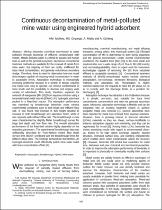 ResearchSpace
ResearchSpace
Continuous decontamination of metal-polluted mine water using engineered hybrid adsorbent
JavaScript is disabled for your browser. Some features of this site may not work without it.
- ResearchSpace
- →
- Research Publications/Outputs
- →
- Conference Publications
- →
- View Item
| dc.contributor.author |
Muliwa, AM

|
|
| dc.contributor.author |
Onyango, MS

|
|
| dc.contributor.author |
Maity, Arjun

|
|
| dc.contributor.author |
Ochieng, A

|
|
| dc.date.accessioned | 2019-03-07T12:13:13Z | |
| dc.date.available | 2019-03-07T12:13:13Z | |
| dc.date.issued | 2018-05 | |
| dc.identifier.citation | Muliwa, A.M. et al. 2018. Continuous decontamination of metal-polluted mine water using engineered hybrid adsorbent. Proceedings of the Sustainable Research and Innovation Conference, JKUAT Main Campus, Kenya, 2-4 May 2018, pp. 155-158 | en_US |
| dc.identifier.issn | 2079-6226 | |
| dc.identifier.uri | https://biust.pure.elsevier.com/en/publications/continuous-decontamination-of-metal-polluted-mine-water-using-eng | |
| dc.identifier.uri | http://sri.jkuat.ac.ke/ojs/index.php/proceedings/article/view/696 | |
| dc.identifier.uri | http://hdl.handle.net/10204/10757 | |
| dc.description | This work is licensed under a Creative Commons Attribution-NonCommercial 4.0 International License. | en_US |
| dc.description.abstract | Mining industries contribute enormously to water pollution through discharge of effluents contaminated with metals. Metals-polluted water is a threat to aquatic and human lives as well as the general ecosystem. Numerous conventional treatment methods are available for the removal of metals from mine water, but majority of them are costly, inefficient for trace metal concentration, and generate voluminous secondary sludge. Therefore, there is need for alternative low-cost novel technologies capable of reducing metal concentration in water to acceptable levels. Adsorption technology is increasingly receiving preference because it is simple in design, requires low initial cost, easy to operate, can remove contaminants in trace levels and the possibility to develop and employ wide variety of adsorbents. This study, therefore, explored the removal of manganese [Mn (II)] from aqueous solution using a bentonite/metal oxide hybrid (B/MeO(sub)x/H) hydrogels adsorbent packed in a fixed-bed reactor. The adsorption performance was examined by breakthrough behaviors under various experimental conditions such as bed height and influent flow rate. It was found that increase in bed height resulted to increase in both breakthrough and saturation times, while it was opposite with influent flow rate. The breakthrough curves were characterized by slightly flatter breakthrough curves for large bed depth and low flow rate. The overall adsorption performance of the fixed-bed column highly depended on the operating parameters. The experimental breakthrough data was sufficiently described by Yoon-Nelson model. Bed depth service time (BDST) predicted well the breakthrough times for different flow rates. The findings demonstrate that B/MeO(sub)x/H hydrogel adsorbent could effectively polish mine water laded with trace concentration of Mn (II). | en_US |
| dc.language.iso | en | en_US |
| dc.publisher | Jomo Kenyatta University of Agriculture and Technology | en_US |
| dc.relation.ispartofseries | Worklist;22074 | |
| dc.subject | Adsorption | en_US |
| dc.subject | Breakthrough | en_US |
| dc.subject | Hybrid | en_US |
| dc.subject | Mine water | en_US |
| dc.title | Continuous decontamination of metal-polluted mine water using engineered hybrid adsorbent | en_US |
| dc.type | Conference Presentation | en_US |
| dc.identifier.apacitation | Muliwa, A., Onyango, M., Maity, A., & Ochieng, A. (2018). Continuous decontamination of metal-polluted mine water using engineered hybrid adsorbent. Jomo Kenyatta University of Agriculture and Technology. http://hdl.handle.net/10204/10757 | en_ZA |
| dc.identifier.chicagocitation | Muliwa, AM, MS Onyango, Arjun Maity, and A Ochieng. "Continuous decontamination of metal-polluted mine water using engineered hybrid adsorbent." (2018): http://hdl.handle.net/10204/10757 | en_ZA |
| dc.identifier.vancouvercitation | Muliwa A, Onyango M, Maity A, Ochieng A, Continuous decontamination of metal-polluted mine water using engineered hybrid adsorbent; Jomo Kenyatta University of Agriculture and Technology; 2018. http://hdl.handle.net/10204/10757 . | en_ZA |
| dc.identifier.ris | TY - Conference Presentation AU - Muliwa, AM AU - Onyango, MS AU - Maity, Arjun AU - Ochieng, A AB - Mining industries contribute enormously to water pollution through discharge of effluents contaminated with metals. Metals-polluted water is a threat to aquatic and human lives as well as the general ecosystem. Numerous conventional treatment methods are available for the removal of metals from mine water, but majority of them are costly, inefficient for trace metal concentration, and generate voluminous secondary sludge. Therefore, there is need for alternative low-cost novel technologies capable of reducing metal concentration in water to acceptable levels. Adsorption technology is increasingly receiving preference because it is simple in design, requires low initial cost, easy to operate, can remove contaminants in trace levels and the possibility to develop and employ wide variety of adsorbents. This study, therefore, explored the removal of manganese [Mn (II)] from aqueous solution using a bentonite/metal oxide hybrid (B/MeO(sub)x/H) hydrogels adsorbent packed in a fixed-bed reactor. The adsorption performance was examined by breakthrough behaviors under various experimental conditions such as bed height and influent flow rate. It was found that increase in bed height resulted to increase in both breakthrough and saturation times, while it was opposite with influent flow rate. The breakthrough curves were characterized by slightly flatter breakthrough curves for large bed depth and low flow rate. The overall adsorption performance of the fixed-bed column highly depended on the operating parameters. The experimental breakthrough data was sufficiently described by Yoon-Nelson model. Bed depth service time (BDST) predicted well the breakthrough times for different flow rates. The findings demonstrate that B/MeO(sub)x/H hydrogel adsorbent could effectively polish mine water laded with trace concentration of Mn (II). DA - 2018-05 DB - ResearchSpace DP - CSIR KW - Adsorption KW - Breakthrough KW - Hybrid KW - Mine water LK - https://researchspace.csir.co.za PY - 2018 SM - 2079-6226 T1 - Continuous decontamination of metal-polluted mine water using engineered hybrid adsorbent TI - Continuous decontamination of metal-polluted mine water using engineered hybrid adsorbent UR - http://hdl.handle.net/10204/10757 ER - | en_ZA |





